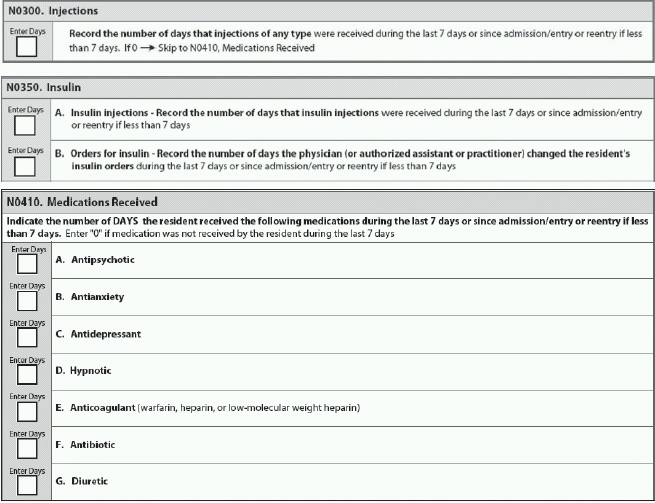Remember to include insulin injections in N0300, not only in N0350.
Mounting scrutiny of unnecessary medications and antipsychotics has made your coding of Section N — Medications more significant than ever before. But are you making these basic blunders when coding medications?
1. Don’t Code Medications for Their Use
For Item N0410 — Medications Received, you must code medications according to their therapeutic category or pharmacological classification, not how they’re prescribed or used, instructed Shirley Boltz, RN, RAI/Education Coordinator for the Kansas Department for Aging and Disability Services, in a recent MDS training session.
2. When to Count Drugs Received Outside the Facility
In Section N, you must code all medications received as a resident of your facility, even if the resident received the medication in another healthcare location, such as a dialysis clinic or another setting, Boltz noted. Code all medications received via any route, such as injection, insulin and certain oral medications.
You can also code injections that the resident received in the emergency room, but don’t code medications received in the hospital if the resident was admitted.
3. When You Can’t Code Long-Acting Meds
Code long-acting medications in N0410 only if given during the look-back period, Boltz instructed. This means that you would code medications given every few weeks or monthly in this item only when the resident received the medication during the seven-day look-back period, or since admission/entry if less than seven days ago.
4. How to Code Combination Drugs
Code combination drugs in all categories that constitute the combination, according to a recent training by the Ohio Department of Health (ODH). This means that you would code each component of the combination drug separately in Item N0410.
5. Include Insulin Injections for N0300, Too
Although you have a separate item, N0350 — Insulin, in this section for coding insulin, you should also code insulin injections in item N0300 — Injections, ODH said. For N0300, count the number of days that the resident received any type of injection while a resident of your facility, and then enter that number in N0350A — Insulin injections. Count the number of days insulin orders were received or changed, and then code this number in N0350B — Orders for insulin.
6. Code Insulin Pumps This Way
And for insulin pumps, you would count only the day that the resident received the injection to start the pump, Boltz noted. If the resident received one or more injections on the same day, you would count only one day.
Also, pay attention to sliding scale insulin orders. If the resident has a sliding scale insulin order, count only the days:
o Initial order received;
o Order revised or changed; and/or
o Order discontinued.
But don’t count when staff administer different doses, Boltz warned.
7. Don’t Include These Types of Meds
There are certain medications that you should not code in Section N, such as herbal or alternative medicine products and over-the-counter sleeping medications used as hypnotics, Boltz said. Also, do not code antiplatelet medications used as anticoagulants.
8. Beware of Unnecessary Medications
Take heed that surveyors will look at Section N to spot unnecessary medications, to cite F-Tag F329. To cite F329, surveyors review the diagnosis, dosage, monitoring for effectiveness (target symptoms and goals), monitoring for side effects, care planning, checking for black box warnings, behavior monitoring, and gradual dose reductions, Boltz noted. This is especially true when using antipsychotics and similar medications for residents with dementia.
Be sure to check the RAI Manual and “black box” information for adverse drug reactions, gradual dose reduction and other care planning considerations, ODH advised.
The black box information for a drug refers to “prominently featured warnings about the need to closely evaluate and monitor the potential benefits and risks of the medication for the person it is being prescribed.”

